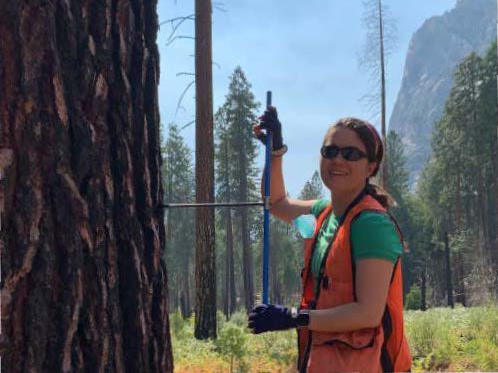
Cribbs and Venuti forest resilience projects funded by CalFire
Restoration and resilience of California forests will benefit from the research of two graduate students whose projects have received state funding. Jennifer Cribbs and Nina Venuti are graduate students studying with Andrew Latimer, a professor in the UC Davis Department of Plant Sciences.
The students share a love of evergreen forests and dedication to improving the management of California ecosystems. Their projects have been funded with competitive grants of nearly $100,000 each through the California Department of Forestry and Fire Protection’s Forest Health Research Program.

Cribbs studies how fire and drought influence trees’ ability to resist bark beetles and other mortality risks. Her CalFire grant will fund fieldwork in remote regions of Sequoia and Kings Canyon National Parks, where she will collect tree cores and analyze tree rings to identify factors affecting tree health and resilience. Bark beetles and drought have killed an estimated 102 million trees in California since 2010, according to the U.S. Forest Service.
Cribbs worked in national forests and parks in the same region for a decade before starting graduate school.
“I’ve been backpacking in the Sierra Nevada since the late 1990s, so I’ve seen a lot of change over the last few decades,” Cribbs said. “But, that’s a blink of an eye compared to what the trees have witnessed over hundreds or even thousands of years. With climate change, trees have to contend with hotter droughts, bigger fires and more bark beetle attacks.”
Venuti’s work will support post-fire restoration efforts in California conifer forests. She will digitize and analyze thousands of historical cone collection records to build predictive models pinpointing when seed cones reach peak ripeness. Those models will help seed collectors plan and implement seed collections across the state, and bolster capacity for reforestation in burned areas.

“I’m especially excited and grateful for the chance to work directly with reforestation practitioners and nursery professionals,” Venuti said. “My goal is that my research will be directly beneficial to land managers who are working hard to reforest California’s burned landscapes.”
Nature and people in intertwined systems
Latimer serves as major professor for both students. “Together, these two projects are perfect examples of what we aim to do at UC Davis,” Latimer said. “Nina and Jennifer will produce new knowledge and tools that support the resilience of both human and natural systems - which are intertwined - to environmental changes that we are all experiencing right now. With this research, they aim to support land managers and other practitioners in their ongoing efforts to make the best use of limited resources as they grapple with the scale of the need for restoration and reforestation.”
Venuti is co-advised by Derek Young, an assistant professional researcher in the department. Cribbs is co-advised by Troy Magney, an associate professor in the department.
Through its Forest Health Research Program, CalFire provides grants to researchers whose work can make a tangible difference in the management of state ecosystems. Cribbs and Venuti are among only five graduate students funded this year.

Related links
Cribbs and Venuti created videos to show their earlier research.
- Cribbs' video is, "Rings and Resin in the Range of Light."
- Venuti's video is, "Every Cone Counts."
Media Resources
- Trina Kleist, UC Davis Department of Plant Sciences, tkleist@ucdavis.edu, (530) 754-6148 or (530) 601-6846
